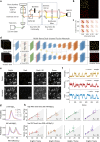Supervised multi-frame dual-channel denoising enables long-term single-molecule FRET under extremely low photon budget
- PMID: 39746928
- PMCID: PMC11697068
- DOI: 10.1038/s41467-024-54652-w
Supervised multi-frame dual-channel denoising enables long-term single-molecule FRET under extremely low photon budget
Abstract
Camera-based single-molecule techniques have emerged as crucial tools in revolutionizing the understanding of biochemical and cellular processes due to their ability to capture dynamic processes with high precision, high-throughput capabilities, and methodological maturity. However, the stringent requirement in photon number per frame and the limited number of photons emitted by each fluorophore before photobleaching pose a challenge to achieving both high temporal resolution and long observation times. In this work, we introduce MUFFLE, a supervised deep-learning denoising method that enables single-molecule FRET with up to 10-fold reduction in photon requirement per frame. In practice, MUFFLE extends the total number of observation frames by a factor of 10 or more, greatly relieving the trade-off between temporal resolution and observation length and allowing for long-term measurements even without the need for oxygen scavenging systems and triplet state quenchers.
© 2025. The Author(s).
Conflict of interest statement
Competing interests: The authors declare no competing interests.
Figures


References
-
- Aggarwal, V. & Ha, T. Single-molecule fluorescence microscopy of native macromolecular complexes. Curr. Opin. Struct. Biol.41, 225–232 (2016). - PubMed
-
- Schwille, P. Fluorescence correlation spectroscopy and its potential for intracellular applications. Cell Biochem. Biophys.34, 383–408 (2001). - PubMed
-
- Ishii, K. & Tahara, T. Two-dimensional fluorescence lifetime correlation spectroscopy. 1. Principle. J. Phys. Chem. B117, 11414–11422 (2013). - PubMed
-
- Wohland, T., Maiti, S. & Macháň, R. An Introduction to Fluorescence Correlation Spectroscopy (IOP Publishing, 2020).
Publication types
MeSH terms
Substances
Grants and funding
LinkOut - more resources
Full Text Sources

